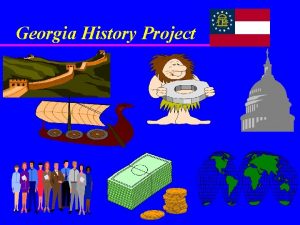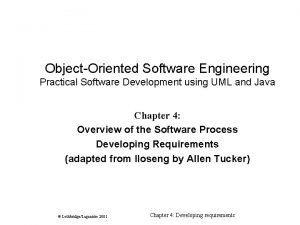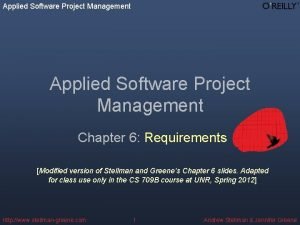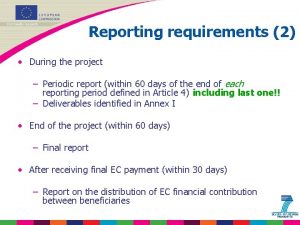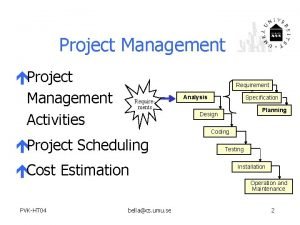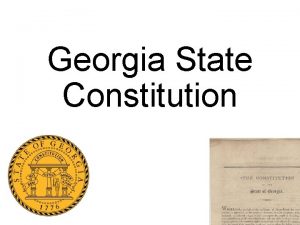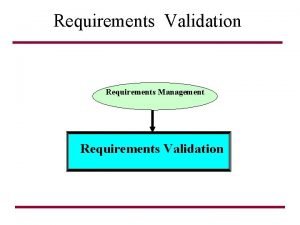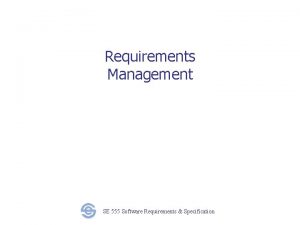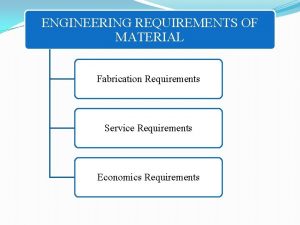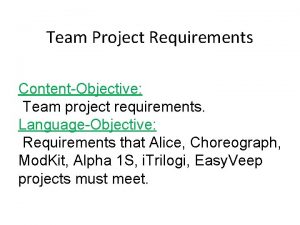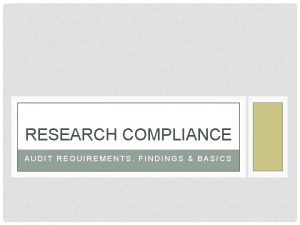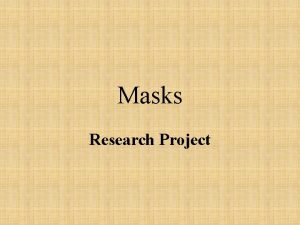Georgia History Project Georgia History Research Project Requirements






































- Slides: 38

Georgia History Project

Georgia History Research Project

Requirements: u Locate ideas in multiple types of sources. u Take notes and develop outlines through reading, listening or viewing. u Develop and interpret charts, tables, timelines, graphs, diagrams, and other graphic aids. u Write research paper explaining topic. u Create visual to accompany your paper.

REQUIRED PARTS OF PROJECT u. Topic identification u. Note-cards u. Bibliography u. Outline u. Research paper u. Visual Presentation of project

STEPS TO A SUCCESSFULLY COMPLETED PROJECT

STEPS TO COMPLETE: u Choose a topic u Formulate question(s) u Determine purpose u Complete research – Find resources – Take notes – Write down resources to use in bibliography – Keep a log of what you do u Organize research – Write an outline

u Write rough draft summary research paper – Introduction – Thesis Statement/ Purpose – Proofread and Revise – Draw a conclusion u Write final draft u Visual Presentation (examples below) – Backboard – Create model – Video

WHAT ARE DISCIPLINES?

DISCIPLINES k. ANTHROPOLOGY k. ECONOMICS k. GEOGRAPHY k. HISTORY k. POLITICAL SCIENCE k. SOCIOLOGY

ANTHROPOLOGY a. Anthropology is the study of human beings from prehistory to the present. a. It includes physical development and cultural heritage. ~

ECONOMICS Economics is the study of the production, consumption, and exchange of goods and services. The way people make and sell products, conduct business, organize labor, and finance these activities. Almost anything to do with business is economics. ~

GEOGRAPHY T Geography is the study of places on earth, man’s utilization of raw materials and resources. T This includes countries, cities. . . , rivers, oceans and seas. . . , mountains and valleys, deserts, etc. ~

HISTORY è History is all that happened to man and is a record of the past. è It tells the story of man from early beginnings. è It tells how countries were formed and perhaps defeated. . . changes. ~

POLITICAL SCIENCE Political science is the study of government. The different ways cultures. . . rule and govern themselves. ]defend themselves ]solve environmental problems ]

SOCIOLOGY a. Sociology is the study of man’s interaction and relationship with his environment. a. It emphasizes man’s attitudes, motivation, social needs, and behaviors. ~

CHOOSING A TOPIC. . . è Pick a topic that interests you. (There may be several ideas that appeal to you. Research these topics and pick the one that will hold your interest for several months. ) è Pick a topic that has enough information for the report requirements. è Your goal is to decide on a topic that you find exciting and pass along the information in the form of the report.

WHERE TO LOOK. . . a Use a variety of sources: apamphlets a magazines a the internet a videos a newspapers a atlases asurveys ainterviews a Topics related to history may be found in encyclopedias or other reference books. a The topic may decide where you look for information. For example, if the topic is a baseball strike, then magazines, internet, or newspapers may be the best choices since it is more of a current events topic.

NARROWING A TOPIC : Choose a topic that is not too broad. For example, World War II is too large. A more specific choice may be the Battle of the Bulge, General George Patton, or Pearl Harbor, etc. : Instead of sports, someone may choose a specific idea about a sport. For example, ticket sales, profit/loss, players/team(s), salaries, or management would narrow the topic somewhat. ~

THE RESEARCH PAPER F The report has very specific requirements. F The body of the report can be no more than 300 words. F 2 -3 double-space typed pages F There must be a bibliography page where sources are cited.

GATHERING AND ANALYZING DATA

ORGANIZATION X X X Keep all information in a folder. . . packet, notes, log of time spent (diary/methodology), and everything associated with this project. Use notecards or a spiral to keep notes that you take. Write all bibliographic information for each source. (The bibliography is title, author, etc. of the material you are using. This is required. ) ~

TAKING NOTES u. Write down only information that is related to the topic u. Write down the source – include information needed to complete bibliography, for example: » author » publisher and date of publication » Internet address

Creating Notecards Select a new index card for each new source. • Create a letter for each source and number each card from that source. Example: A 1, A 2, B 1, B 2, … Source A: The Chronicle of Western Fashion: From Ancient Times to the Present Day Source B: "Is Trade Embargo with Cuba Hurting U. S. Interests? " •


TAKING NOTES. . . è Write any information you find on the topic on notecards. Include all bibliographic information. è Do not write exactly what is printed in a book. You must paraphrase (put in your own words). If you choose to write exactly, you will need to give credit to the author and the page found. Don’t forget to put this on your notecard. è You might not use all the notes taken or there may be too little information. ~

OUTLINING o WEBBING, FLOW CHART, STANDARD OUTLINE o You may choose any one of these outlining techniques to organize the data for the report. o This gives you a “path” to follow to make the report flow. o An outline shows main idea, subtopics, and supporting details. ~

Outline

USE GRAPHS / CHARTS TO SHOW DATA.

INTERVIEW è You optional may interview someone who has knowledge of your topic. For example, a student may contact a store manager to discuss profit and loss or some other aspect of economics. è You may interview family members for a topic about family history. è Be sure to cite this in the report on the credit page. ~

SURVEYS optional The survey is questions you have written concerning your topic. 4 You may survey your classmates in order to gather data about their opinions on your subject. (What is your favorite. . . ? How many_do you own. . . ? When. . . ? Who. . . ? Why. . . ? ) 4 It may be wise to offer A. . . B. . . C. . . D. . . choices to narrow the variety of some answers. 4 You will want to graph this information (and put it on the backboard, if you choose to do one). ~ 4

BIBLIOGRAPHY Credit must be given to all sources used in the report. 4 Each type of resource has its own format but generally contain the same information such as title, author, place of publication, publisher’s name, date of publication. 4 Sort by author’s last name in ABC order. Underline titles of books; place quotes around chapters. End each source with a period. 4 Use the information given in the packet for the different ways to cite resources. ~ 4

Bibliography Sample u Author’s last name, first name. Title of Book. Place of publication: Publisher’s name, date of publication. Fradin, Dennis B. Georgia in Words and Pictures. Chicago: Children’s Press, 1981.

WRITING A RESEARCH PAPER W W W Prewriting. . . what interests me? How can I make it interesting to others? First draft. . . write. (Editing comes later. ) Revising. . . make changes in first draft. Be sure sentences are not too short or too long. Ask someone else to read your report. Sometimes others find things we don’t see. Proofreading. . . find and edit mistakes in spelling, grammar, and punctuation. Final copy. . . may be typed or hand written in ink. If someone else types it, a verification page is necessary. ~

FORMAT for the RESEARCH PAPER Ý Ý Ý Title page - name, school, etc. Research - information on your topic (300 words max) Bibliography - list of titles, authors, etc. (in ABC order by author’s last name)

MODELS (must be created by YOU!!!) u Models u Diagrams u Murals u Filmstrips u Dioramas u Historical u Recordings collections u Video tapes u Maps u Slides u Films u Artifacts u Graphs u Charts u Photographs

DON’T WAIT UNTIL THE LAST MINUTE! Keep on schedule. Be aware of DUE dates. ¤ Work at a reasonable pace. ¤ Avoid panic by not waiting until the last minute. ~ ¤

Due Dates u Topic Identification: Wed. , April 26 u Note Cards: Monday, May 1 – (minimum 15 notecards using minimum 3 sources) u Bibliography: Tuesday, May 2 u Outline or Graphic Organizer: Wednesday, May 3 u Research Paper: Monday, May 8 end of class u Presentation due: Week of May 15 -17

In Conclusion. . . v The social studies report is probably your first experience with writing a formal term paper. v You will learn so much about the topic as well as about yourself. v When all is finished, you will be proud of yourself for the hard work, the long hours, and the good job you have done! v Congratulations!
 Research project requirements
Research project requirements Georgia high school requirements
Georgia high school requirements Rough draft example
Rough draft example Georgia tech operations research
Georgia tech operations research Domain analysis document
Domain analysis document Budget for project proposal
Budget for project proposal Green field project requirements
Green field project requirements Epa requirements for quality assurance project plans
Epa requirements for quality assurance project plans Project management software requirements checklist
Project management software requirements checklist Periodic report example
Periodic report example Project management activities
Project management activities Georgia history timeline 1877-1919
Georgia history timeline 1877-1919 Georgia tech project management
Georgia tech project management Georgia project for assistive technology
Georgia project for assistive technology Georgia habitats 3rd grade project
Georgia habitats 3rd grade project Research report vs research proposal
Research report vs research proposal Methodology vs research design
Methodology vs research design Positivism vs constructivism
Positivism vs constructivism What is conclusive research design
What is conclusive research design Basic research vs applied research
Basic research vs applied research What is research gap in research paper
What is research gap in research paper Contrast applied research and basic research
Contrast applied research and basic research How a research problem is formulated
How a research problem is formulated Research instrument in experimental research
Research instrument in experimental research 40 days baby in womb
40 days baby in womb Correlational research
Correlational research Chapter 3 introduction example
Chapter 3 introduction example Example of applied research
Example of applied research Bryman bell
Bryman bell Purpose of research
Purpose of research Qualitative vs quantitative research
Qualitative vs quantitative research What is inquiry in practical research 2
What is inquiry in practical research 2 Cross sectional vs longitudinal
Cross sectional vs longitudinal The major emphasis in exploratory research is on
The major emphasis in exploratory research is on Objectives of research example
Objectives of research example Research instrument in experimental research
Research instrument in experimental research Importance of qualitative research
Importance of qualitative research Axial coding vs open coding
Axial coding vs open coding History research environment
History research environment
